download ebook at ebookgate.com
Philosophyrevisioncritiquerereading practicesinHeideggerNietzscheandEmerson 1stEditionHeidegger
https://ebookgate.com/product/philosophy-revisioncritique-rereading-practices-in-heideggernietzsche-and-emerson-1st-edition-heidegger/
Download more ebook from https://ebookgate.com
More products digital (pdf, epub, mobi) instant download maybe you interests ...
The philosophy of Heidegger 1st Edition Heidegger
https://ebookgate.com/product/the-philosophy-of-heidegger-1stedition-heidegger/
Basic Concepts of Ancient Philosophy Martin Heidegger
https://ebookgate.com/product/basic-concepts-of-ancientphilosophy-martin-heidegger/
Heidegger and happiness dwelling on fitting and being 1st Edition Heidegger
https://ebookgate.com/product/heidegger-and-happiness-dwellingon-fitting-and-being-1st-edition-heidegger/
Heidegger and the Earth Essays in Environmental Philosophy 2nd Edition Ladelle Mcwhorter (Editor)
https://ebookgate.com/product/heidegger-and-the-earth-essays-inenvironmental-philosophy-2nd-edition-ladelle-mcwhorter-editor/
Rosenzweig and Heidegger Between Judaism and German Philosophy 1st Edition Peter Eli Gordon
https://ebookgate.com/product/rosenzweig-and-heidegger-betweenjudaism-and-german-philosophy-1st-edition-peter-eli-gordon/
Heidegger in America 1st Edition Martin Woessner
https://ebookgate.com/product/heidegger-in-america-1st-editionmartin-woessner/
The Beginning of Western Philosophy Interpretation of Anaximander and Parmenides Martin Heidegger
https://ebookgate.com/product/the-beginning-of-westernphilosophy-interpretation-of-anaximander-and-parmenides-martinheidegger/
Mindfulness 1st Edition Martin Heidegger
https://ebookgate.com/product/mindfulness-1st-edition-martinheidegger/
The Aesthetic Paths of Philosophy Presentation in Kant Heidegger Lacoue Labarthe and Nancy 1st Edition Alison Ross
https://ebookgate.com/product/the-aesthetic-paths-of-philosophypresentation-in-kant-heidegger-lacoue-labarthe-and-nancy-1stedition-alison-ross/
PHILOSOPHY , REVISION , CRITIQU E
DAVI D WITTENBER G
Philosophy, Revision, Critique
Rereading Practices in Heidegger, Nietzsche, and Emerson
STANFOR D UNIVERSIT Y PRES S
STANFORD , CALIFORNI A 2OO I
Stanford UniversityPress Stanford, California
© 2001 by the Board ofTrustees of the Leland Stanford Junior University
Printed in the United States of America on acid-free, archival-qualitypaper
Library of Congress Cataloging-in-PublicationData Wittenberg, David.
Philosophy, revision,critique :rereadingpracticesin Heidegger, Nietzsche, and Emerson / David Wittenberg p. cm.
Includes bibliographicalreferences andindex.
ISBN 0-8047-3415-1 (alk paper)
i.Methodology. 2.Hermeneutics. 3.Philosophy—Historiography. 4. Heidegger, Martin, 1889-1976. Nietzsche. I. Title.
BD24I.W58 20OI
101—dcii
Original Printing 2001
Last figure belowindicatesyear of this printing: 10 09 08 07 06 05 04 03 02 01
Typeset by Robert C. Ehle in 10/13Janson
00-045047
For Agnes and Albert Wittenberg
Acknowledgments
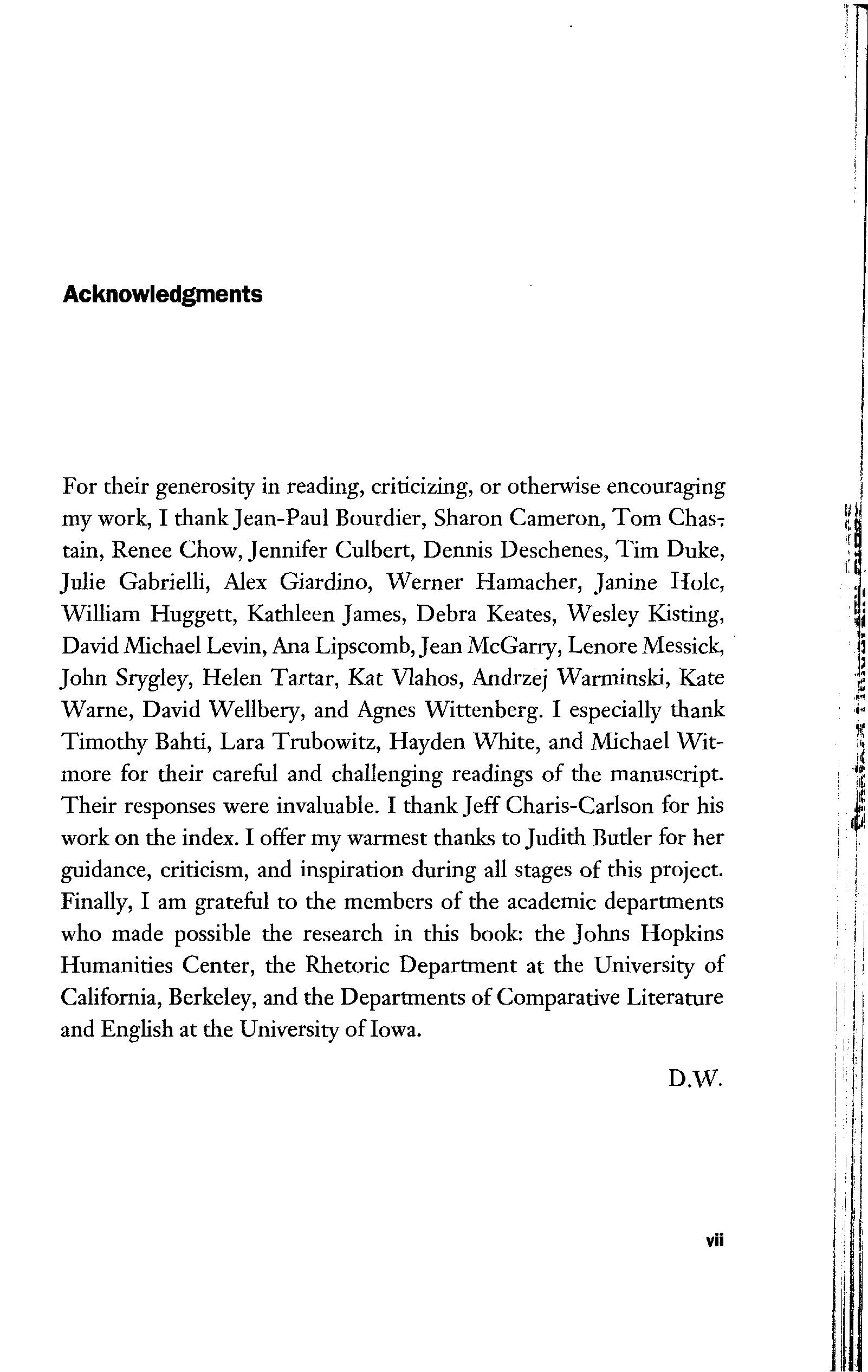
For their generosity in reading, criticizing, or otherwise encouraging my work, I thankJean-Paul Bourdier, Sharon Cameron, Tom Chas-; tain, Renee Chow, Jennifer Culbert, Dennis Deschenes, Tim Duke, Julie Gabrielli, Alex Giardino, Werner Hamacher, Janine Hole, William Huggett, Kathleen James, Debra Keates, Wesley Kisting, David Michael Levin, AnaLipscomb,Jean McGarry, Lenore Messick, John Srygley, Helen Tartar, Kat Vlahos, Andrzej Warminski, Kate Warne, David Wellbery, and Agnes Wittenberg. I especially thank Timothy Bahti, Lara Trubowitz, Hayden White, and Michael Witmore for their careful and challenging readings of the manuscript. Their responses were invaluable. I thank Jeff Charis-Carlson for his work on the index I offer my warmest thanks toJudith Butler for her guidance, criticism, and inspiration during all stages of this project. Finally, I am grateful to the members of the academic departments who made possible the research in this book: the Johns Hopkins Humanities Center, the Rhetoric Department at the University of California, Berkeley, and the Departments of Comparative Literature and English at the University of Iowa
D.W.
1. The Art of ReadingProperly, Part i:
2 The Art of ReadingProperly, Part 2:
Paralipsis,Part i: A Rhetoric of Rereading
4. Paralipsis,Part 2:Revisionas History of Being
Interlude: The Reception of Revision
5. Revision as Canon Formation: Misreading in Harold Bloom
6. Healthy, Wealthy, and Wise: Rereadingin Emerson
7. Thought for Food (Eating Eternal Return)
A SuggestionAbout Canon Formation
Abbreviations
AI Bloom, The Anxiety of Influence
AR Jauss, Toward an Aesthetic of Reception
BT Heidegger, Being and Time
E Emerson, Essays and Lectures
EP Heidegger, The End of Philosophy
MM Bloom,A Map of Misreading
Ne Heidegger, Nietzsche (inEnglish), volumes i through 4
Ng Heidegger, Nietzsche (in German), volumes i and 2
S Nietzsche, Studienausgabe, volumes i through 15
VA Heidegger, Vortrdge undAufsatze
WP Nietzsche, The Will to Power
PHILOSOPHY , REVISION , CRITIQU E
Oh, Time, Strength, Cash, and Patience!
MELVILLE, Moby Dick
Introduction
This book is a critique of revision in philosophical texts and in the histories formed by those texts. Revision has rarely been considered a problem within the discipline of philosophy, even by thinkers for whom the rhetorical and intertextual characteristics of philosophical thinking are crucial. One ofmy goals is to help reorient the critique of philosophical textuality around the particular rereading strategies that enable philosophical texts to form, and conform to, canons of inquiry and presentation. This goal allies my study with literary critics concerned with the generic and institutional characteristics of philosophical writing, an alliance which shifts the book away from the disciplinary center at which the traditional philosophical topoi—ontology, epistemology, ethics, and so forth—still hold sway. But philosophy, as it confronts us today and asit has for a long time, is such aweb of tex-
INTRODUCTIO N
tual affiliations and contraventions that not even a philosopher ought to be surprised if an eccentric analysisof the ways philosophers reread and revise one another ends by proposing a theory of the philosophical itself. It may turn out that the philosophical disciplinecomprises less a forum for inquiring about the world or the beings within it than aforum in the much older sense, a marketplacein which what is produced andtraded isnot primary or secondary philosophical goods, but instead an elaborate kind of gossip about other philosophers.
My argument willproceed from twopremises that, although unsurprising in themselves, together produce implications that have not yet been fully understood either by philosophers or by their critics. The first premise isthat philosophical practice is historical, not simplyin the sense that philosophies belong to varyingperiods or epochs, but more precisely, in the sense that philosophies develop into and out of canons, and that philosophicalthinking within such canons conforms to historically determined forms of inquiry and presentation—in essence, that philosophy is a genre. The second premise, in part following upon the first, is that philosophy is textual. The endowment of philosophy consists almost exclusively of a body of written artifacts, constructed and produced through a set of strict protocols according to which such artifacts may be published, disseminated, reread, and criticized, in their minor dialectical divergences from kindred texts.A combination of these two premises gives a starting point for the critique I will conduct here: philosophy is revision, a history of textual alterations, or more concisely, a textual historicity.
The immediate consequence of any rigorous application of the notion that philosophy is revision is the obsolescence of any conception of "first philosophy," in the sense of a prior or foundational discourse upon which other philosophical—as well as social, political, or scientific—thinking is grounded. There remain few professional philosophers who would still abide by a first philosophy as a starting point for either scientific or humanistic inquiry. But the residues of first philosophy, and of foundationalist thinking in general, stillsurvive
and pervade the practices of actual philosophical writing, a powerful legacy of more or less silent shibboleths concerning the way philosophy is supposed to be done, or the wayit issupposed to be represented as having been done.
One of these shibboleths isthe figure of the solitary thinker, whose ostensibly antipractical and metasocial vocation sets apart his or her practice of philosophical thinking from worldlier intellectual tasks,and whose ostensible detachment from investment in anyparticular typeof object exempts him or her from the more mundane commitments entailed by other scientific pursuits. The solitary thinker persists asthe presumptive source and originator of philosophical "thoughts" or "inquiry" despite our current easy self-consciousness about the invalidity of armchair speculation and the social and psychological debts of authorial subjects. Philosophers continue to behave, by convention, as though the primaryvocation ofphilosophy were the ratiocination ofa single inquiring individual, and philosophical writing therefore a sort of documentary report about what that inquiry had accomplished. This is regardless ofthe fact that in the late professional milieu of philosophy what maintains one asa philosopher isprecisely that one does not sit alone and inquire; rather, that one enters the marketplace, writes, and publishes—or at least teaches philosophy at a university, which increasingly verges on the same thing. The available modes of philosophical research still tend to demand at least a stance of de facto speculative autarky,a pretense of solitary "first" thinking, largelyaside from the understanding that what wedo asphilosophical practitioners is primarily reread, react to, and write anew about what is alreadywritten down, for the benefit of narrow professional audiences.
If we take seriously, and combine rigorously, the premises that the practice of philosophy is essentially historical and textual, then there can be neither any first philosophy nor any solitary thinking, perhaps not even in a form critics of philosophy could comfortably challenge and negate. The denial of the primacy of any given philosophical position entailed by a truly strict historicism must occur not for the rela-
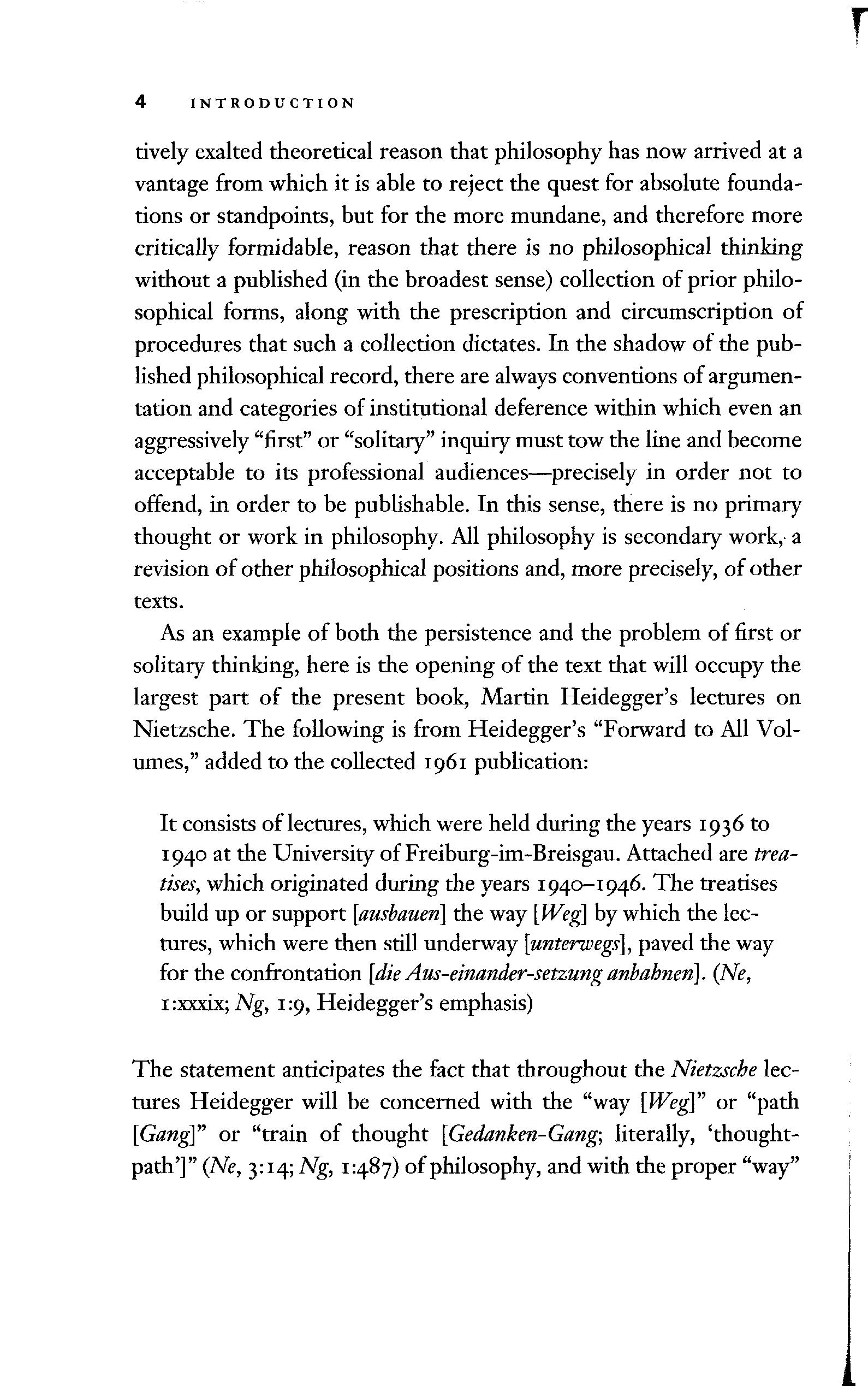
tively exaltedtheoretical reason that philosophy has now arrived at a vantage from which it is able to reject the quest for absolute foundations or standpoints, but for the more mundane, and therefore more critically formidable, reason that there is no philosophical thinking without a published (in the broadest sense) collection of prior philosophical forms, along with the prescription and circumscription of procedures that such a collection dictates. In the shadow of the published philosophical record, there are alwaysconventions of argumentation and categories of institutional deferencewithin which even an aggressively "first" or "solitary" inquiry must tow the line and become acceptable to its professional audiences—precisely in order not to offend, in order to be publishable.In this sense, there is no primary thought or work in philosophy. All philosophy is secondary work, a revision of other philosophical positions and, more precisely, of other texts
As an exampleof both the persistence and the problem of first or solitary thinking, here is the opening of the text that will occupy the largest part of the present book, Martin Heidegger's lectures on Nietzsche. The following is from Heidegger's "Forward to All Volumes," addedto the collected 1961 publication:
It consists of lectures, which were held during the years 1936 to 1940 at the University of Freiburg-im-Breisgau. Attached are treatises, which originated during the years 1940-1946 The treatises build up or support [ausbauen} the way [Weg[ by which the lectures, which were then still underway [unterwegs], paved the way for the confrontation [dieAus-einander-setzung anbahnen]. (Ne, i:xxxix; Ng, 119, Heidegger's emphasis)
The statement anticipates the fact that throughout the Nietzsche lectures Heidegger will be concerned with the "way [Weg]" or "path [Gang]" or "train of thought [Gedanken-Gang; literally, 'thoughtpath']" (Ne, 3:14; Ng, 1:487) of philosophy, and with the proper "way"
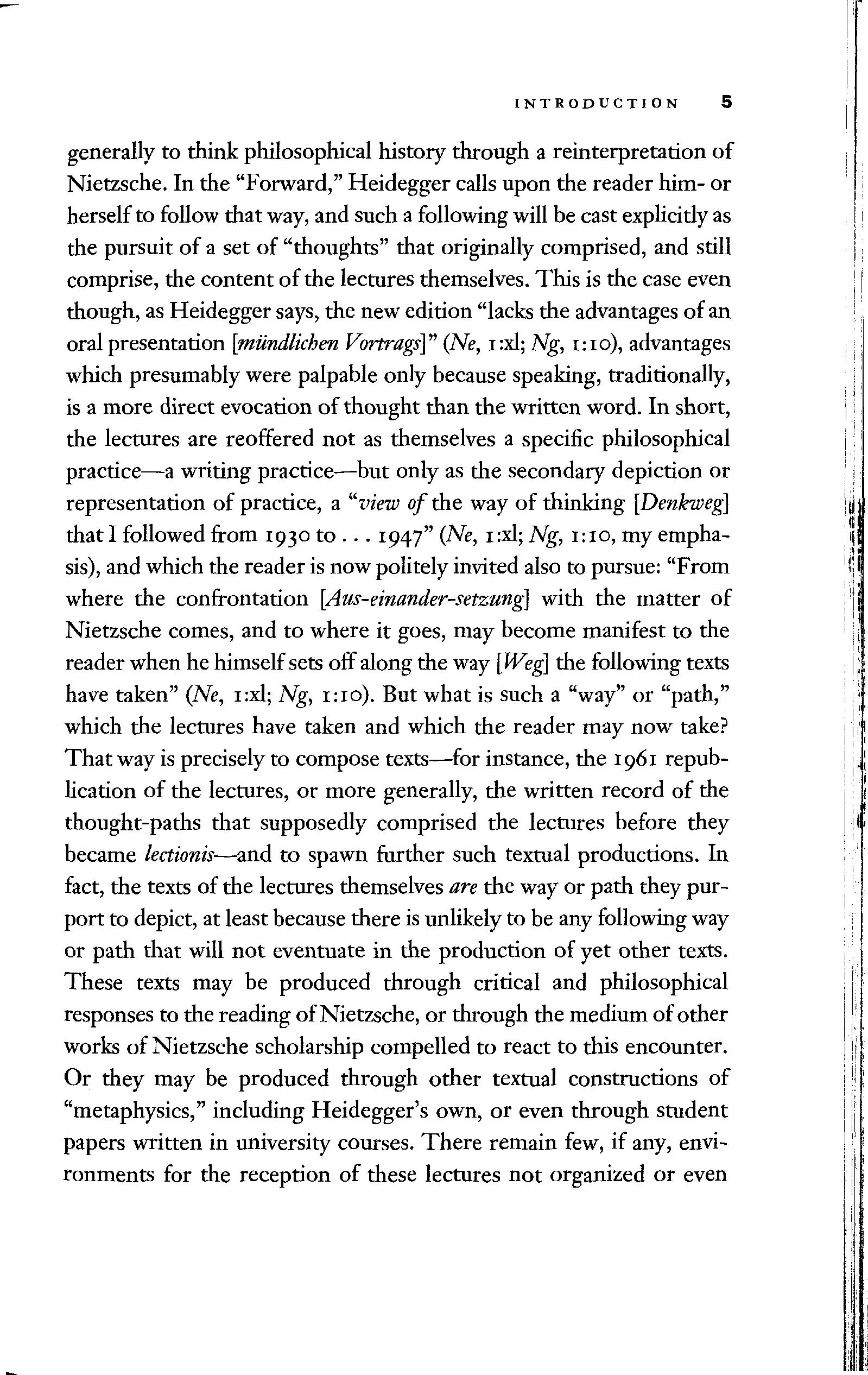
generally to think philosophical history through a reinterpretation of Nietzsche. In the "Forward," Heidegger calls upon the reader him- or herself to follow that way,and such a followingwill be cast explicitlyas the pursuit of a set of "thoughts" that originally comprised, and still comprise, the content of the lectures themselves This is the caseeven though, asHeidegger says,the new edition "lacks the advantages ofan oral presentation [miindlichen Vortrags]" (Ne, i:xl; Ng, 1:10),advantages which presumablywere palpableonly because speaking, traditionally, is a more direct evocation of thought than the written word. In short, the lectures are reoffered not as themselves a specific philosophical practice—a writing practice—but only as the secondary depiction or representation of practice, a "view of the way of thinking [Denkiveg] that I followed from 1930 to ... 1947" (Ne, i:xl; Ng, i:io, myemphasis), and which the reader isnow politely invited also to pursue: "From where the confrontation [Aus-einander-setzung] with the matter of Nietzsche comes, and to where it goes, may become manifest to the reader when he himself sets off along the way [ffieg] the followingtexts have taken" (Ne, i:xl; Ng-, 1:10). But what is such a "way" or "path," which the lectures have taken and which the reader may now take? That wayisprecisely to compose texts—for instance, the 1961 republication of the lectures, or more generally, the written record of the thought-paths that supposedly comprised the lectures before they became lectionis—and to spawn further such textual productions In fact, the texts of the lectures themselves are the way or path they purport to depict, at least becausethere isunlikelyto be any followingway or path that will not eventuate in the production of yet other texts. These texts may be produced through critical and philosophical responses to the reading ofNietzsche, or through the mediumof other works of Nietzsche scholarship compelled to react to this encounter. Or they may be produced through other textual constructions of "metaphysics," including Heidegger's own, or even through student papers written in university courses. There remain few,if any, environments for the reception of these lectures not organized or even
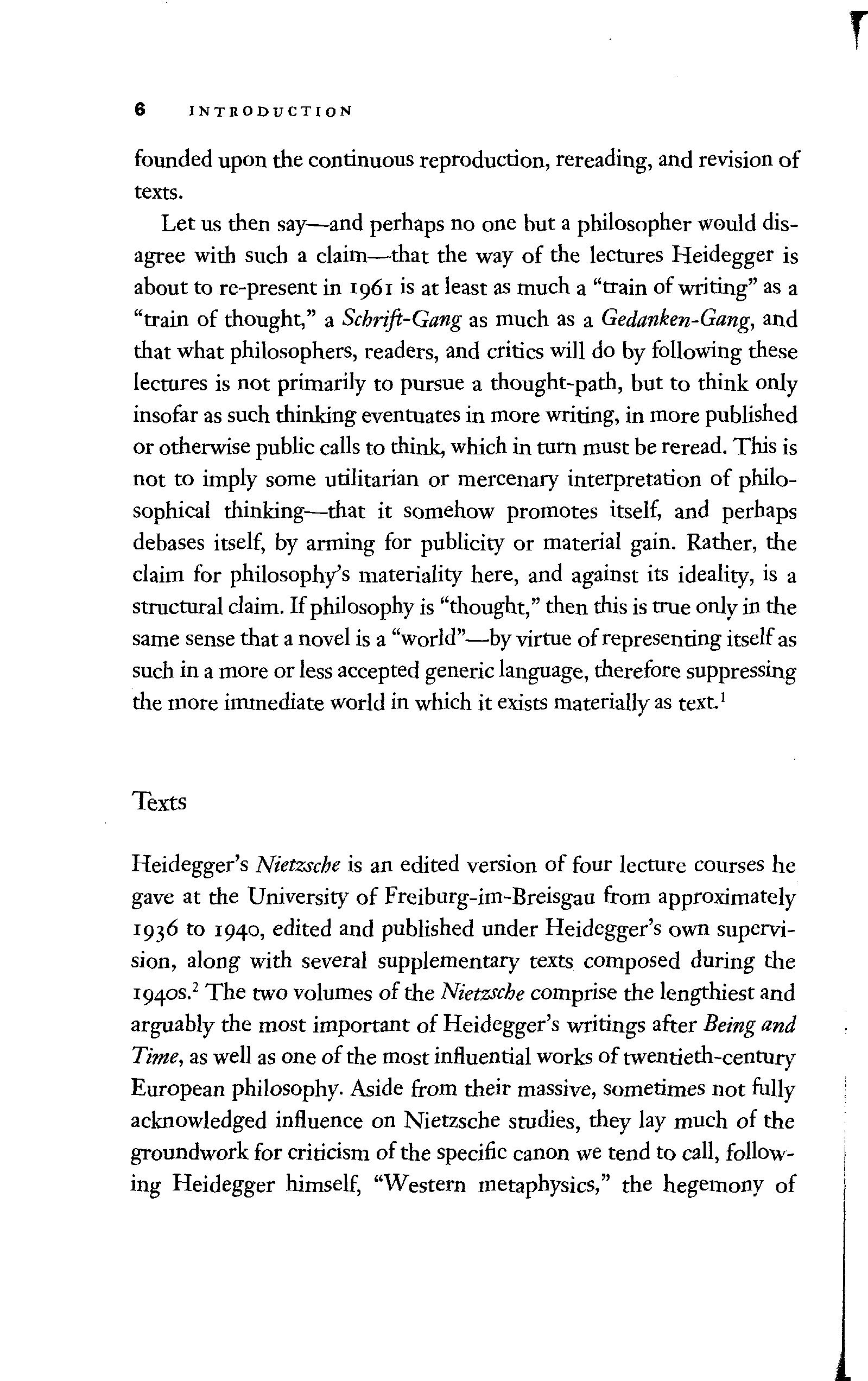
INTRODUCTIO N
founded upon the continuous reproduction, rereading,and revisionof texts.
Let us then say—and perhaps no one but a philosopher would disagree with such a claim—that the way of the lectures Heidegger is about to re-present in 1961 is at least asmuch a "train ofwriting" asa "train of thought," a Schrift-Gang as much as a Gedanken-Gang, and that what philosophers, readers, and critics will do by following these lectures is not primarily to pursue a thought-path, but to think only insofar assuch thinking eventuatesin more writing, in more published or otherwise public callsto think, which in turn mustbe reread.This is not to imply some utilitarian or mercenary interpretation of philosophical thinking—that it somehow promotes itself, and perhaps debases itself, by arming for publicity or material gain Rather, the claim for philosophy's materiality here, and against its ideality, is a structural claim.Ifphilosophy is"thought," then this istrue only in the same sense that anovel is a "world"—byvirtue of representing itself as such in amore or less accepted generic language, therefore suppressing the more immediate world in which it exists materially astext.1
Texts
Heidegger's Nietzsche is an edited version of four lecture courses he gave at the University of Freiburg-im-Breisgau from approximately 1936 to 1940, edited and published under Heidegger's own supervision, along with several supplementary texts composed during the 1940S.2 The two volumes ofthe Nietzsche comprise the lengthiest and arguably the most important of Heidegger's writings after Being and Time, aswell asone ofthe most influentialworks of twentieth-century European philosophy. Aside from their massive, sometimes not fully acknowledged influence on Nietzsche studies, they lay much of the groundwork for criticism ofthe specific canon wetend to call, following Heidegger himself, "Western metaphysics," the hegemony of
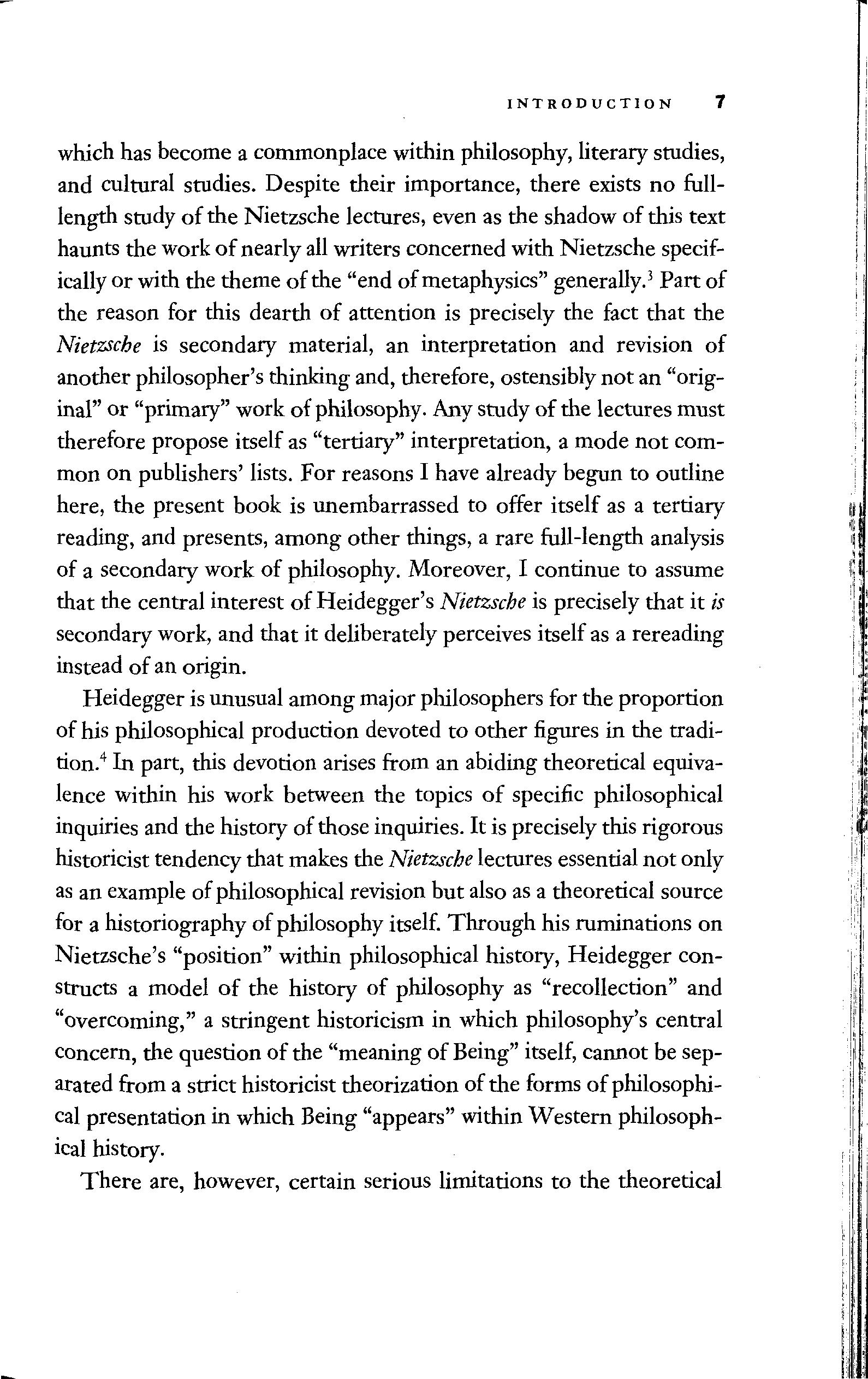
which has become a commonplace within philosophy, literarystudies, and cultural studies. Despite their importance, there exists no fulllength study of the Nietzsche lectures, even as the shadowof this text haunts the workof nearly allwriters concerned with Nietzsche specifically or with the theme of the "end ofmetaphysics" generally.3 Part of the reason for this dearth of attention is precisely the fact that the Nietzsche is secondary material, an interpretation and revision of another philosopher's thinking and,therefore, ostensiblynot an "original" or "primary" work ofphilosophy.Anystudy of the lectures must therefore propose itself as "tertiary" interpretation, a mode not common on publishers' lists. For reasons I have already begun to outline here, the present book is unembarrassed to offer itself as a tertiary reading, and presents, among other things, a rare full-length analysis of a secondary work of philosophy. Moreover, I continue to assume that the central interest of Heidegger's Nietzsche is precisely that it is secondary work, and that it deliberately perceives itself as a rereading instead of an origin.
Heidegger isunusualamong major philosophers for the proportion of his philosophical production devoted to other figures in the tradition.4 In part, this devotion arises from an abidingtheoretical equivalence within his work between the topics of specific philosophical inquiries and the history ofthose inquiries. It is preciselythis rigorous historicist tendency that makes the Nietzsche lectures essentialnot only as an example ofphilosophical revision but alsoas a theoretical source for a historiography of philosophy itself. Through his ruminations on Nietzsche's "position" within philosophical history, Heidegger constructs a model of the history of philosophy as "recollection" and "overcoming," a stringent historicism in which philosophy's central concern, the question of the "meaning of Being"itself, cannot be separated from a strict historicist theorization ofthe forms of philosophical presentation in which Being"appears" within Western philosophical history
There are, however, certain serious limitations to the theoretical
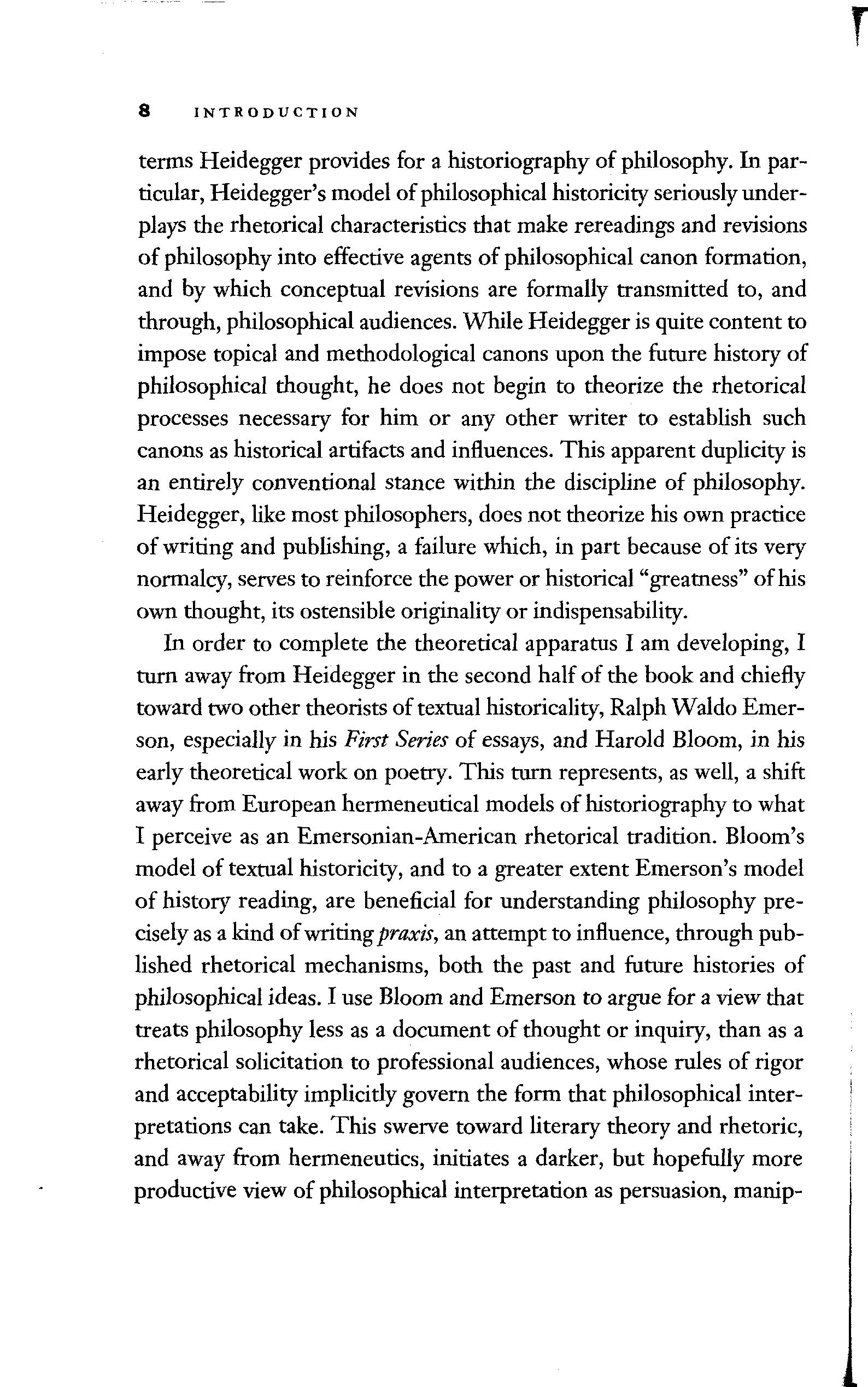
terms Heidegger provides for a historiography of philosophy. In particular, Heidegger's modelofphilosophical historicity seriouslyunderplays the rhetorical characteristics that make rereadings and revisions of philosophy into effective agents of philosophical canon formation, and by which conceptual revisions are formally transmitted to, and through, philosophical audiences.While Heidegger isquite content to impose topical and methodological canons upon the future history of philosophical thought, he does not begin to theorize the rhetorical processes necessary for him or any other writer to establish such canons ashistorical artifacts and influences.This apparent duplicityis an entirely conventional stance within the discipline of philosophy. Heidegger, likemost philosophers, does not theorize his ownpractice of writing and publishing, a failure which, in part because of its very normalcy, servesto reinforce the power or historical "greatness" ofhis own thought, its ostensible originality or indispensability.
In order to complete the theoretical apparatus I am developing, I turn away from Heidegger in the second half of the book and chiefly toward two other theorists oftextualhistoricality, RalphWaldo Emerson, especially in his First Series of essays, and Harold Bloom, in his early theoretical work on poetry. This turn represents, aswell, a shift away from European hermeneutical models ofhistoriography to what I perceive as an Emersonian-American rhetorical tradition Bloom's model of textual historicity, and to a greater extent Emerson's model of history reading, are beneficial for understanding philosophy precisely asakind of writingpraxis, an attempt to influence, through published rhetorical mechanisms, both the past and future histories of philosophical ideas. I use Bloom and Emerson to argue for aview that treats philosophy less as a document of thought or inquiry, than asa rhetorical solicitation to professionalaudiences,whose rules of rigor and acceptability implicitly govern the form that philosophical interpretations can take. This swervetoward literary theory and rhetoric, and away from hermeneutics, initiates a darker, but hopefully more productive view of philosophical interpretation as persuasion, manip-
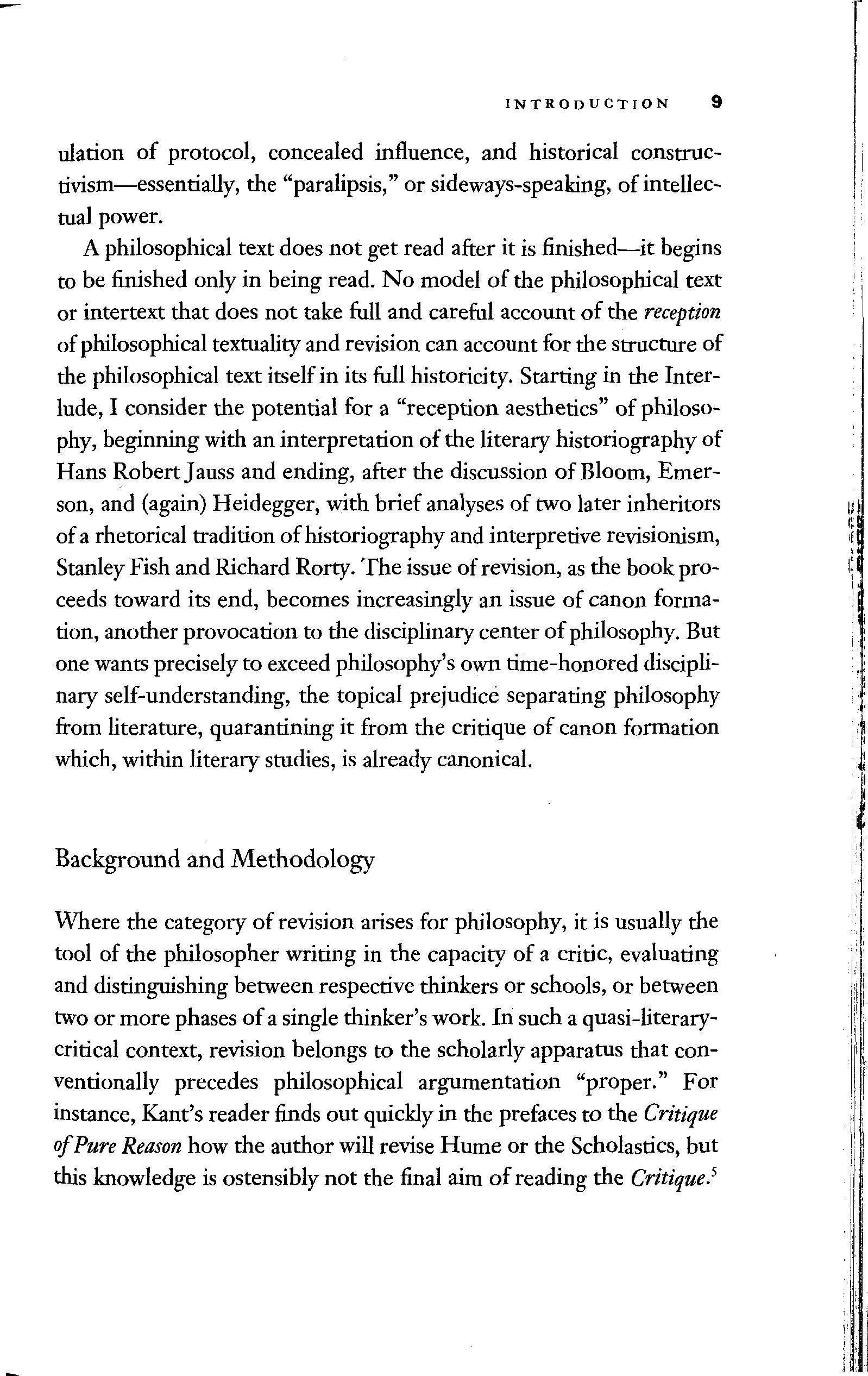
ulation of protocol, concealed influence, and historical constructivism—essentially,the "paralipsis," or sideways-speaking,of intellectual power.
A philosophical text does not get read after it is finished—it begins to be finished only in being read. No model of the philosophical text or intertext that does not take full and careful account of the reception of philosophical textuality and revision can account for the structure of the philosophical text itselfin its full historicity. Starting in the Interlude, I consider the potential for a "reception aesthetics" of philosophy, beginning with an interpretation of the literary historiography of Hans RobertJauss and ending, after the discussion of Bloom, Emerson, and (again) Heidegger, with brief analyses of two later inheritors of a rhetorical tradition of historiography and interpretive revisionism, Stanley Fish and Richard Rorty. The issueofrevision, asthe book proceeds toward its end, becomes increasingly an issue of canon formation, another provocation to the disciplinarycenter of philosophy. But one wantspreciselyto exceedphilosophy's own time-honored disciplinary self-understanding, the topical prejudice separating philosophy from literature, quarantining it from the critique of canon formation which, within literary studies,is alreadycanonical.
Background and Methodology
Where the category of revision arises for philosophy, it is usually the tool of the philosopher writing in the capacity of a critic, evaluating and distinguishing between respective thinkers or schools, or between two or more phasesof asingle thinker's work. In such a quasi-literarycritical context, revision belongs to the scholarly apparatus that conventionally precedes philosophical argumentation "proper." For instance, Kant's readerfindsout quicklyin the prefaces to the Critique of Pure Reason how the author will revise Hume or the Scholastics, but this knowledge is ostensibly not the final aim of reading the Critique.5
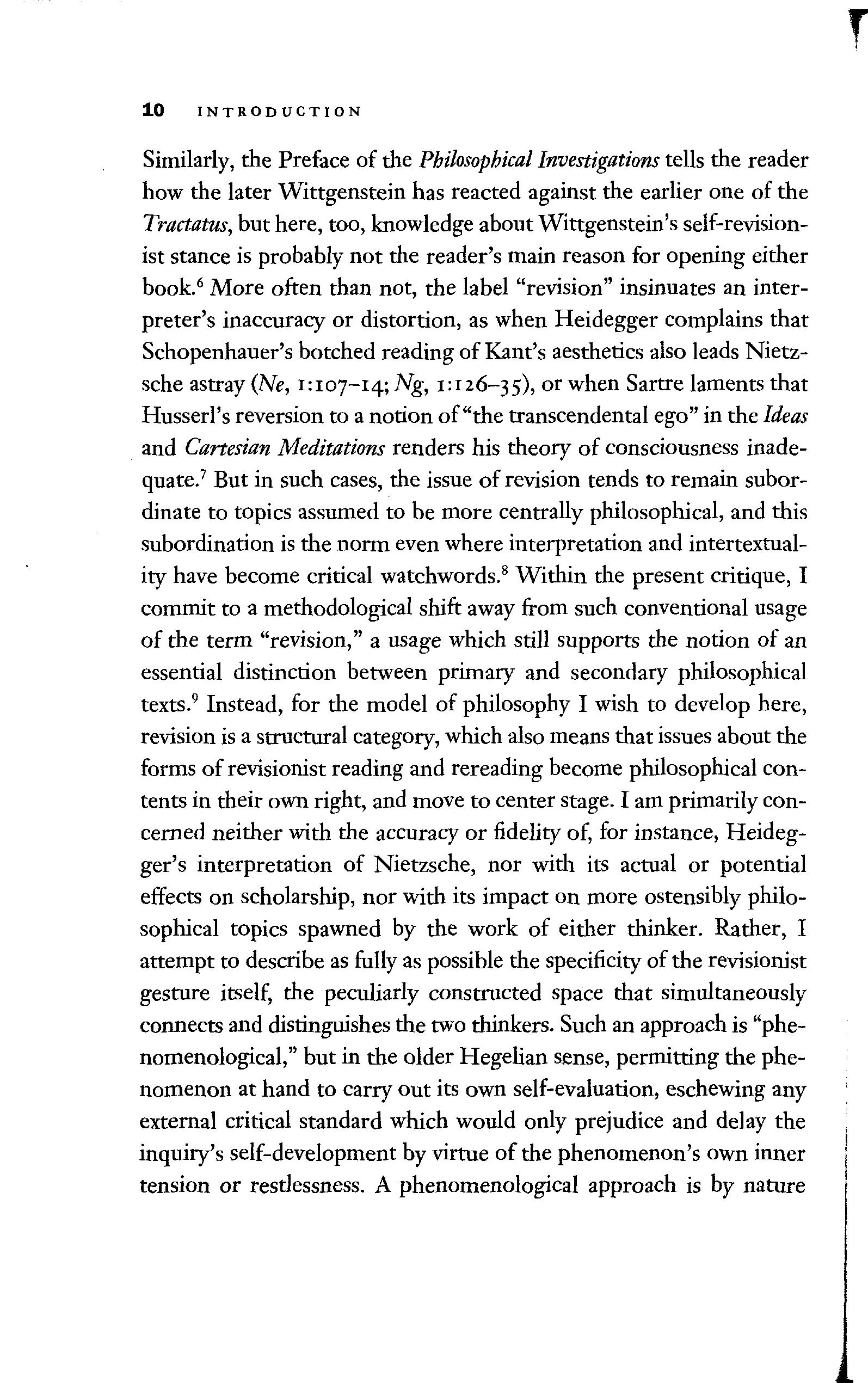
Similarly, the Preface of the Philosophical Investigations tells the reader how the later Wittgenstein has reacted against the earlier one of the Tractatus, but here, too, knowledgeabout Wittgenstein's self-revisionist stance is probably not the reader's main reason for opening either book.6 More often than not, the label "revision" insinuates an interpreter's inaccuracy or distortion, as when Heidegger complains that Schopenhauer's botched readingof Kant's aesthetics also leads Nietzsche astray(A/1?, 1:107-14; Ng, 1:126-35), or when Sartre laments that Husserl's reversion to anotion of"the transcendental ego" in the Ideas and Cartesian Meditations renders his theory of consciousness inadequate.7 But in such cases, the issue of revision tends to remain subordinate to topics assumed to be more centrally philosophical,and this subordination isthe norm evenwhereinterpretation and intertextuality have become critical watchwords.8 Within the present critique, I commit to a methodological shift away from such conventional usage of the term "revision," a usage which still supports the notion of an essential distinction between primary and secondary philosophical texts.9 Instead, for the model of philosophy I wish to develop here, revision isastructural category, whichalsomeansthat issuesabout the forms of revisionist reading and rereading become philosophical contents in their ownright, andmove to center stage. I amprimarily concerned neither with the accuracy or fidelity of, for instance, Heidegger's interpretation of Nietzsche, nor with its actual or potential effects on scholarship, nor with its impact on more ostensibly philosophical topics spawned by the work of either thinker. Rather, I attempt to describe asfully as possible the specificity of the revisionist gesture itself, the peculiarly constructed space that simultaneously connects and distinguishes the twothinkers. Such an approach is "phenomenological," but in the older Hegelian sense, permitting the phenomenon at hand to carry out its own self-evaluation,eschewing any external critical standard which would only prejudice and delay the inquiry's self-developmentby virtue of the phenomenon's own inner tension or restlessness. A phenomenological approach is by nature
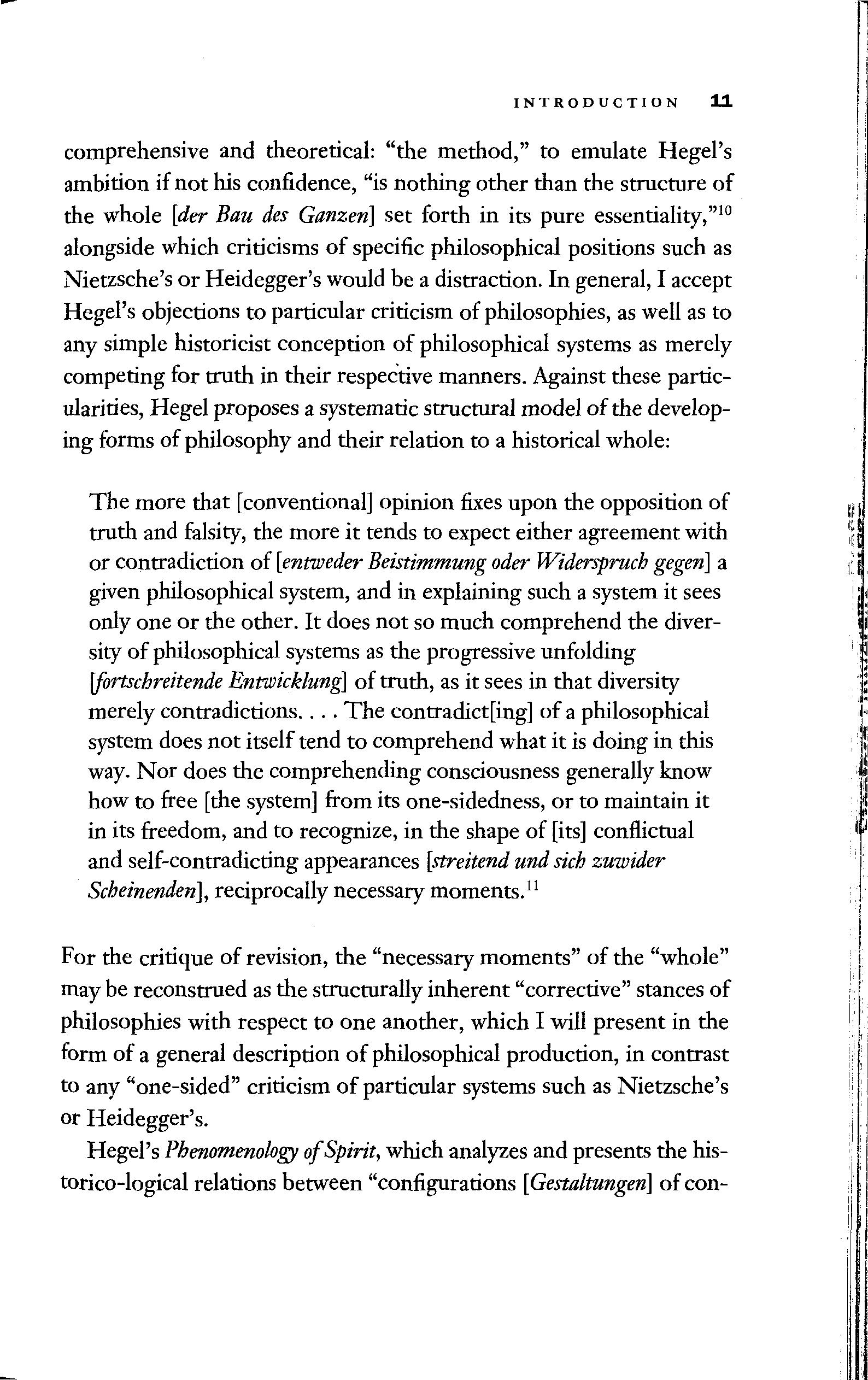
comprehensive and theoretical: "the method," to emulate Hegel's ambition ifnot his confidence, "isnothing other than the structure of the whole [der Ban des Ganzen] set forth in its pure essentiality,"10 alongside which criticisms of specific philosophical positions such as Nietzsche's or Heidegger's would be adistraction. In general, I accept Hegel's objections to particular criticism of philosophies, aswell as to any simple historicist conception of philosophical systems as merely competing for truth in their respective manners Against these particularities, Hegel proposes asystematic structural model ofthe developing forms ofphilosophy and their relation to a historical whole:
The more that [conventional] opinion fixes upon the opposition of truth and falsity, the more it tends to expect either agreement with or contradiction of [entweder Beistimmung oder Widerspruch gegen] a given philosophical system, and in explaining such a system it sees only one or the other. It does not somuch comprehend the diversity of philosophical systems asthe progressive unfolding \fortschreitende Entwicklung\ of truth, as it sees in that diversity merely contradictions.... The contradicting] of a philosophical system does not itself tend to comprehend what it is doing in this way. Nor does the comprehending consciousness generally know how to free [thesystem] from its one-sidedness, or to maintain it in its freedom, and to recognize, in the shape of [its] conflictual and self-contradicting appearances [streitend und sich zuivider Scheinenden], reciprocally necessary moments.11
For the critique of revision, the "necessary moments" of the "whole" may be reconstrued asthe structurally inherent "corrective" stancesof philosophies with respect to one another, which I will present in the form of a general description of philosophical production, in contrast to any "one-sided" criticism of particular systems such as Nietzsche's or Heidegger's.
Hegel's Phenomenology of Spirit, which analyzesand presents thehistorico-logical relations between "configurations [Gestaltungen] of con-
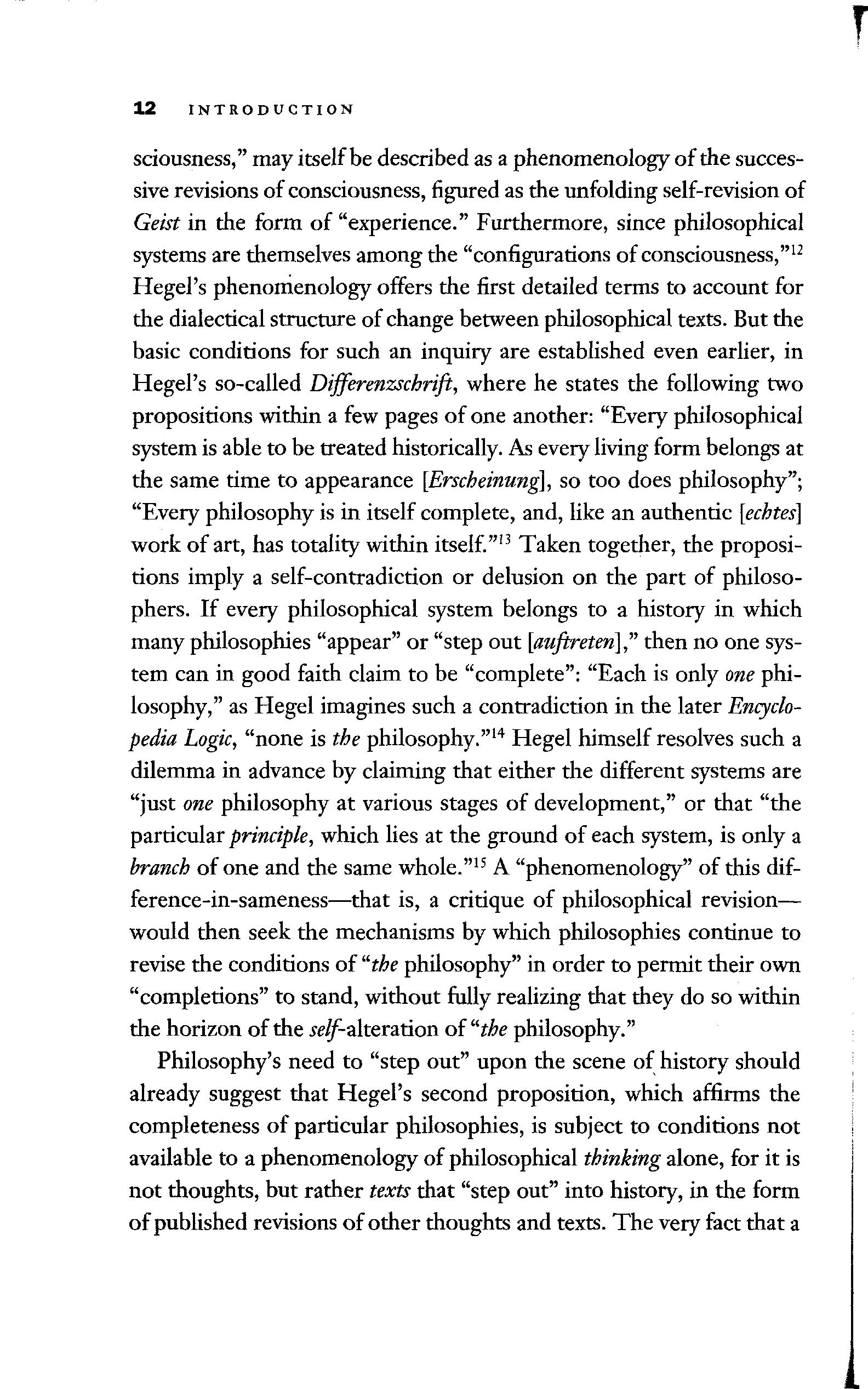
sciousness," mayitself be described asaphenomenology ofthe successive revisions of consciousness, figured as the unfoldingself-revisionof Geist in the form of "experience." Furthermore, since philosophical systems are themselvesamongthe "configurationsof consciousness,"12 Hegel's phenomenology offers the first detailed terms to account for the dialecticalstructure of change betweenphilosophicaltexts But the basic conditions for such an inquiry are established even earlier, in Hegel's so-called Differenzschrift, where he states the following two propositions within a few pages of one another: "Every philosophical system is ableto be treated historically Aseverylivingform belongs at the same time to appearance [Erscheinung], so too does philosophy"; "Every philosophy is in itself complete, and,like an authentic [echtes] work of art, has totality within itself."13 Taken together, the propositions imply a self-contradiction or delusion on the part of philosophers If every philosophical system belongs to a history in which many philosophies "appear" or "step out [auftreten]" then no onesystem can in good faith claim to be "complete": "Each is only one philosophy," as Hegel imagines such a contradiction in the later Encyclopedia Logic, "none is the philosophy."14 Hegel himself resolves such a dilemma in advanceby claiming that either the different systems are "just one philosophy at various stages of development," or that "the particular principle, which lies at the ground of each system, is only a branch of one and the samewhole."15 A "phenomenology" of this difference-in-sameness—that is, a critique of philosophical revision would then seek the mechanisms by which philosophies continue to revise the conditions of "thephilosophy" in order to permit their own "completions" to stand, without fully realizing that they do so within the horizon of the ^//-alteration of "the philosophy."
Philosophy's need to "step out"upon the scene of history should already suggest that Hegel's second proposition, which affirms the completeness of particular philosophies, is subject to conditions not available to a phenomenology of philosophical thinking alone, for it is not thoughts, but rather texts that "step out"into history, in the form of published revisions of other thoughts and texts The veryfact that a
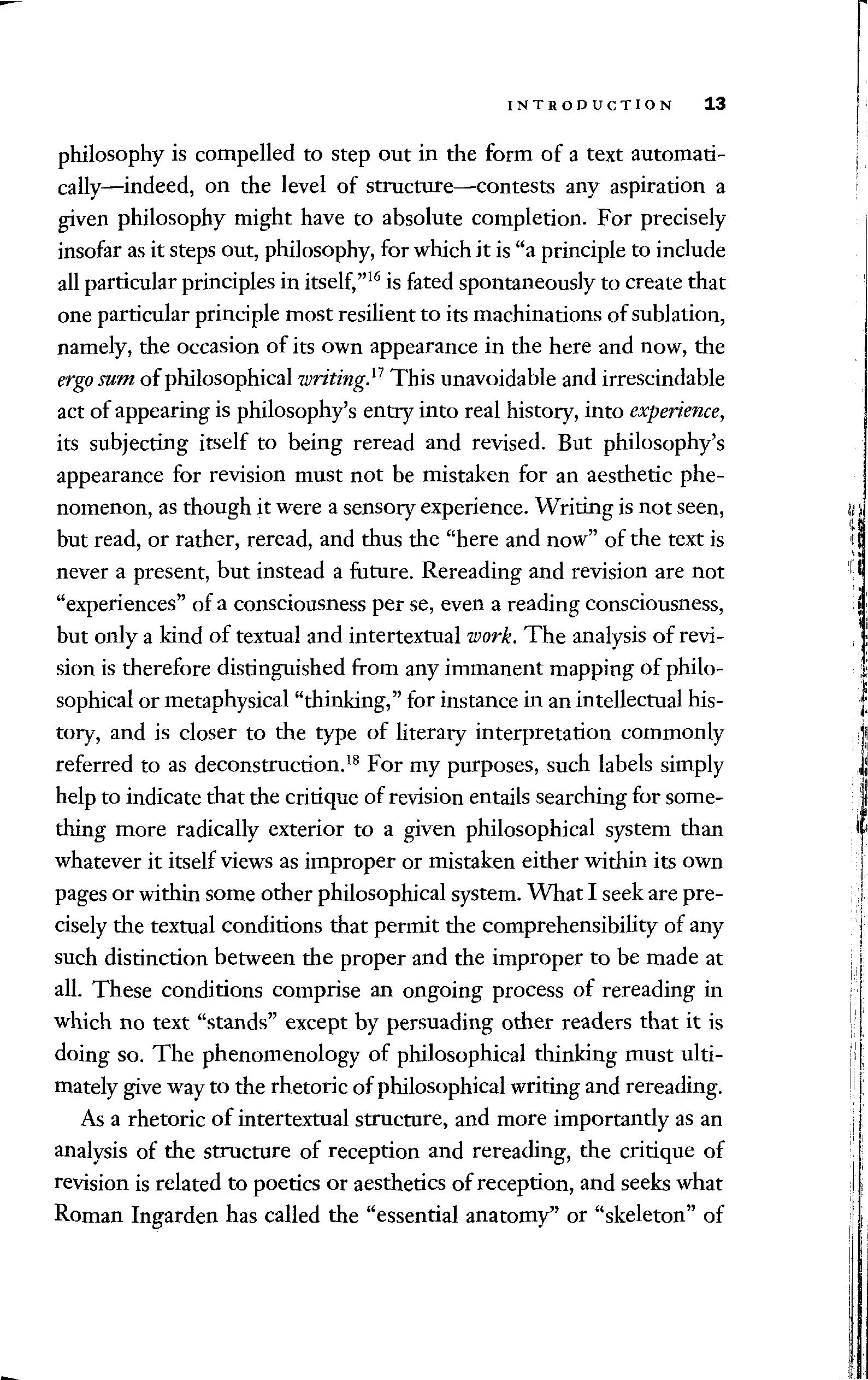
philosophy is compelled to step out in the form of a text automatically—indeed, on the level of structure—contests any aspiration a given philosophy might have to absolute completion. For precisely insofar asit steps out, philosophy, for which it is"a principle toinclude all particular principles in itself,"16 is fated spontaneously to create that one particular principle most resilient to its machinations ofsublation, namely, the occasion of its own appearancein the here and now, the ergo sum of philosophical writing.11 This unavoidableandirrescindable act of appearing is philosophy's entry into real history, into experience, its subjecting itself to being reread and revised. But philosophy's appearance for revision must not be mistaken for an aesthetic phenomenon, asthough it were asensory experience Writing isnot seen, but read, or rather, reread, and thus the "here and now" of the textis never a present, but instead a future. Rereading and revision are not "experiences" of a consciousness per se, even a reading consciousness, but only a kind of textual and intertextual work. The analysisof revision is therefore distinguished from any immanent mapping of philosophical or metaphysical "thinking," for instance in an intellectual history, and is closer to the type of literary interpretation commonly referred to as deconstruction.18 For my purposes, such labels simply help to indicate that the critique ofrevision entails searching for something more radically exterior to a given philosophical system than whatever it itself views as improper or mistaken either within its own pages or within some other philosophical system. What I seekare precisely the textual conditions that permit the comprehensibility of any such distinction between the proper and the improper to be made at all. These conditions comprise an ongoing process of rereading in which no text "stands" except by persuading other readers that it is doing so. The phenomenology of philosophical thinking must ultimately givewayto the rhetoric ofphilosophical writing and rereading
As a rhetoric of intertextual structure, and more importantly as an analysis of the structure of reception and rereading, the critique of revision isrelated to poetics or aesthetics of reception, and seekswhat Roman Ingarden has called the "essential anatomy" or "skeleton" of
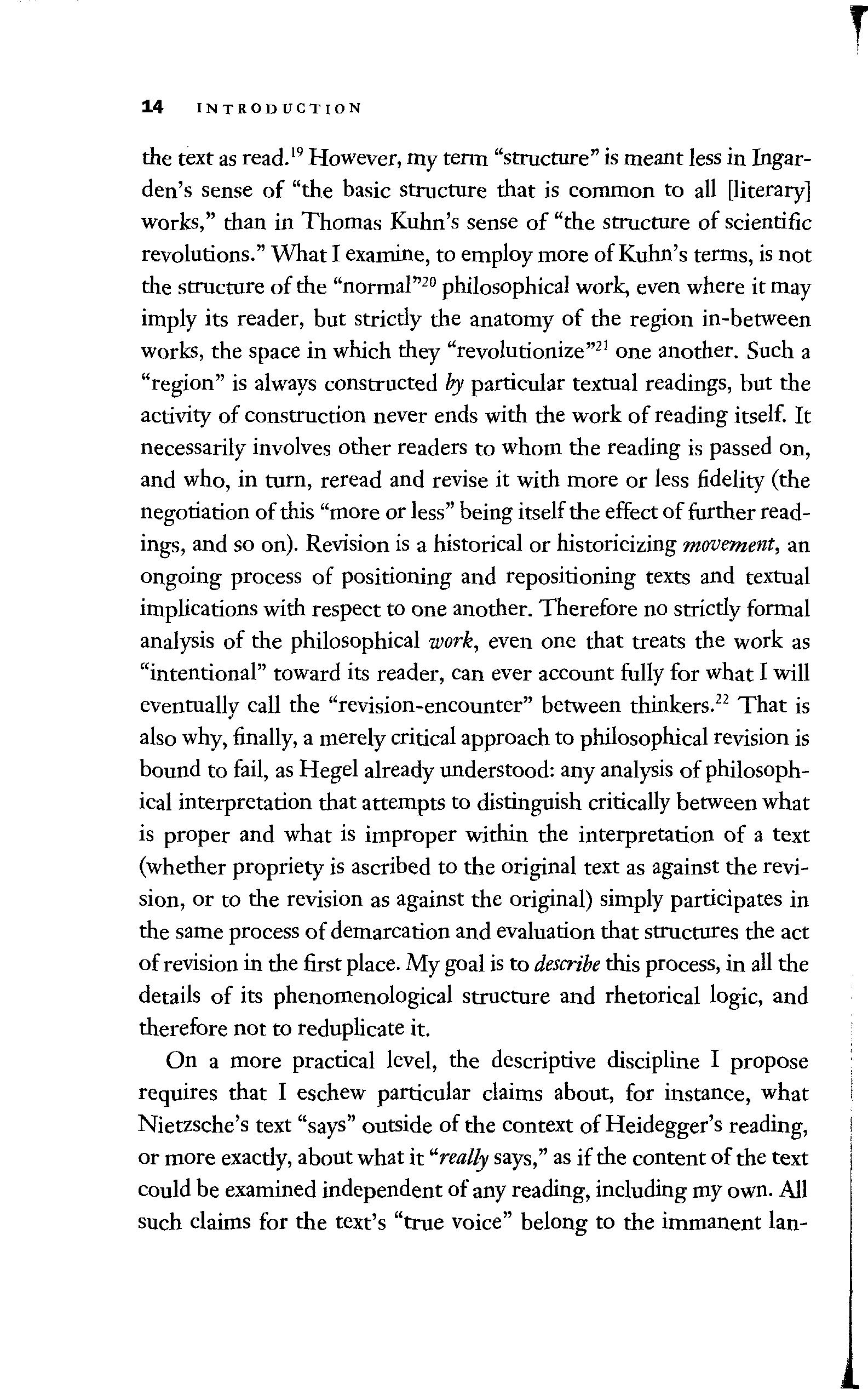
the text asread.19 However, myterm "structure"ismeant less in Ingarden's sense of "the basic structure that is common to all [literary] works," than in Thomas Kuhn's sense of "the structure of scientific revolutions." What I examine,to employ more ofKuhn's terms, is not the structure of the "normal"20 philosophical work, even where it may imply its reader, but strictly the anatomy of the region in-between works, the space in which they "revolutionize"21 one another. Such a "region" is always constructed by particular textual readings, but the activity of construction never ends with the work of reading itself. It necessarily involves other readers to whom the reading is passed on, and who, in turn, reread and revise it with more or less fidelity (the negotiation of this "more or less" being itself the effect of further readings, and so on) Revision is a historical or historicizing movement, an ongoing process of positioning and repositioning texts and textual implications with respect to one another. Therefore no strictly formal analysis of the philosophical work, even one that treats the work as "intentional" toward its reader, can ever account fully for what I will eventually call the "revision-encounter" between thinkers.22 That is also why,finally,a merely critical approach to philosophical revision is bound to fail, asHegel alreadyunderstood: any analysisof philosophical interpretation that attempts to distinguish critically between what is proper and what is improper within the interpretation of a text (whether propriety is ascribed to the original text as against the revision, or to the revision as against the original) simply participates in the same process of demarcation and evaluation that structures the act of revision in the first place.My goal isto describe this process, in all the details of its phenomenological structure and rhetorical logic, and therefore not to reduplicate it
On a more practical level, the descriptive discipline I propose requires that I eschew particular claims about, for instance, what Nietzsche's text "says" outside of the context of Heidegger's reading, or more exactly,about what it "really says,"asif the content of the text could be examinedindependent of any reading, including my own.All such claims for the text's "true voice" belong to the immanent Ian-
Another random document with no related content on Scribd:
Man sollte meinen, daß in einem Gemeinwesen, wie dem dieser Indianer, eine gewisse Gesetzlosigkeit herrscht. Diebstahl ist unbekannt, d. h. Diebstahl von den eigenen Mitgliedern des Stammes, denn es herrscht dort ein so großes Gemeingefühl, daß niemand zu stehlen braucht. Ich glaube auch nicht, daß die Indianer sich gegenseitig belügen. Dem Weißen lügt man etwas vor, man sagt ihm ganz einfach, was man für nützlich für den Stamm hält. Man betrügt ihn, wenn es paßt, man sagt ihm die Wahrheit, wenn es nicht schaden kann. Ertappt man einen Indianer auf einer Unwahrheit, so betrachtet er es ungefähr so, wie ein Weißer die Entdeckung eines Aprilscherzes. Er lacht und findet es amüsant. Wird man ärgerlich, so hält er den Betreffenden offenbar für dumm.
Abb. 5. Ashluslaypapa mit seinem kleinen Jungen. Rio Pilcomayo.
Der Mord beschränkt sich auf den Kinder- und Elternmord, dies ist aber vom indianischen Standpunkt kein Verbrechen. Das klingt ja schrecklich. Die Indianerin betrachtet es als ihr Recht, die Leibesfrucht abzutreiben und ihr Neugeborenes zu töten, wenn sie will. Sie glaubt offenbar ein Recht an dem Leben zu haben, das sie gegeben. Die Abtreibung der Leibesfrucht geschieht durch mechanische Behandlung in weit vorgeschrittenem Stadium[16] und kommt somit, wenigstens bei den Chorotis, immer in den Fällen vor, wo unverheiratete Frauen schwanger werden. Die neugeborenen
Kinder werden getötet, wenn die Mutter von dem Vater verlassen wird, und immer, wenn sie mißgestaltet sind. Ich kenne mehrere solche Kindesmörderinnen, die liebe und gutherzige Mädchen sind. Ein solches ist z. B. Ashlisi, ein Mädchen, das einige lustige Zeichnungen, von denen zwei weiterhin wiedergegeben sind, für mich gemacht hat. Unserer Ansicht nach sollte ein solches Verbrechen eine Frau verrohen. Das ist ein vollständiger Irrtum, denn das Verbrechen verroht erst, wenn es Verachtung seitens der Umgebung verursacht.
Wenn ein Indianer seine alte blinde Mutter oder seinen verkrüppelten Vater tötet, so befreit er sie selbst von einem Leben, das ihnen eine Last ist, und sich selbst von einer Extramühe im Kampfe ums Dasein. Daß sie dieselben zuweilen lebend verbrennen, wie mein Dolmetscher Flores es einmal bei einer alten Frau seitens der Chorotis gesehen hat, erscheint uns natürlich grausam. Möglicherweise haben sie indessen die Alten im Verdacht der Hexerei gehabt. Die sittliche Freiheit ist, wie ich hier unten schildern werde, sehr groß. Untreue und Eifersucht werden durch Schlägereien zwischen den Frauen geordnet. Ein grobes Verbrechen ist auch das Verhexen. Leider weiß ich nicht, wie es bestraft wird.
Im Verhältnis zu anderen besser organisierten Stämmen sind solche Gemeinwesen, wie es die Choroti- und Ashluslayindianer bilden, äußerst schwach. Die beste Gelegenheit, dies zu beobachten, hatte ich während meines Aufenthaltes bei den letzteren. Diese waren, wie erwähnt, in einen Krieg mit den Tobas verwickelt, welche unter Leitung des energischen Häuptlings Taycolique mehrere Überfälle in deren Gebiet machten. Infolge der Machtlosigkeit der Häuptlinge und der geringen Eintracht vermochten sie nicht, sich zu einer gemeinsamen Verteidigung gegen den Feind zu organisieren. Die verschiedenen Dörfer vereinigten sich nicht, sondern jedes tat, was es für gut hielt. Das anarchistische Gemeinwesen hat keine Abwehrkraft. Erwartete man einen Tobaanfall, so eilten viele Männer von verschiedenen Seiten herbei, um den Kampf aufzunehmen, da es aber an jeder Organisation fehlte, fanden sich immer nur ein Teil
der Krieger ein. Die meisten blieben, um ihre eigene Person besorgt, aus.
Es fehlte ein Mann, der zu befehlen und sich Gehorsam zu schaffen verstand.
Das Indianerhaus.
Sowohl bei den Chorotis wie bei den Ashluslays finden wir die von Photographien und Reiseschilderungen bekannte runde oder ovale Chacohütte. Sie ist, je nach der Jahreszeit, mehr oder weniger sorgfältig gebaut und etwa zwei bis vier Meter im Durchschnitt. Zum Schutz gegen die kalten, südlichen Winterwinde sind die in der Ebene liegenden Hütten besser gebaut als die im Walde. Oft sind mehrere Hütten so zusammengebaut, daß sie aus mehreren Räumen mit mindestens einem für jede Familie bestehen. Die Hütten sind aus Zweigen verfertigt, die in die Erde gesteckt, in der Mitte zusammengebogen und mit Gras bedeckt sind. Ein Bindematerial fehlt vollständig. Keine Hütte ist mit Erde oder Lehm bedeckt. Der Eingang, der, falls die Hütte in der Ebene liegt, aus einem kleinen schiefen Gang besteht (Abb. 2), ist nicht nach einer gewissen Himmelsrichtung, sondern meistens nach dem Dorfe zu gerichtet. Viele Hütten haben mehrere Eingänge. Einige sind so schlecht gebaut, daß man ungefähr überall hineinkommen kann. Bei den Ashluslays habe ich über drei Meter hohe wohlgebaute Hütten gesehen. Gewöhnlich ist die Hütte jedoch inwendig nicht ganz zwei Meter und der Eingang ungefähr ein Meter hoch. Bei diesen Indianern findet sich auch ein viereckiger Hüttentypus, und zwar die Kochhütten (Abb. 6). Diese haben platte, mit Gras bedeckte Dächer und dienen zum Kochen und Wohnen am Tage und in warmen Nächten. Auf ihren Dächern pflegt man Fische zu trocknen. In einigen Ashluslaydörfern sah ich mehrere solche unregelmäßig zusammengebaute Kochhütten mitten auf dem offenen Platze des Dorfes. Diese Gebäude, die hier eine
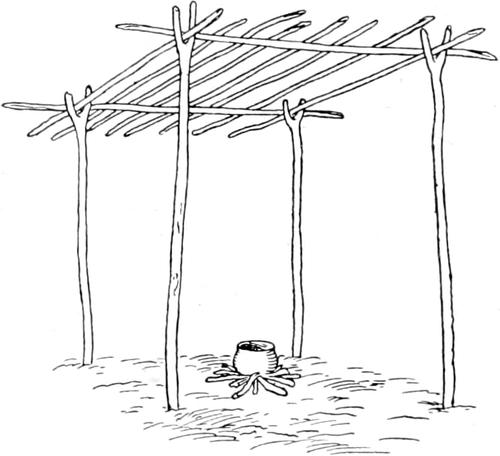
Abb. 6. Kochhütte der Chorotis. Rio Pilcomayo. ungewöhnliche Größe haben, werden während der Trinkfeste als Sonnenzelte angewendet.
Die Frauen suchen das Material zum Hausbau zusammen und bauen auch die Hütten.
Es ist wirklich merkwürdig, daß Volksstämme, die z. B. in der Webetechnik so weit wie diese Indianer gekommen sind, die Ackerbau und Viehzucht haben, sich mit so elenden Hütten begnügen. In regnerischen Nächten habe ich in ihnen Schutz gesucht und genau gesehen, wie die Indianer dort leben. Gießt es ordentlich, so regnet es überall hinein und Menschen und Sachen werden naß. In diesen kleinen Hütten, wo oft mehrere Familien zusammenwohnen, ist der Raum sehr beschränkt, und wenn in einer solchen Regennacht alle zu Hause sind, kann nicht jeder ausgestreckt liegen. Ich selbst habe geringe Bequemlichkeitsbedürfnisse, ich bin aber doch kein Freund davon, daß eine Person quer über meinen Beinen liegt oder daß ein mit Läusen behafteter Kopf auf meinem Kopfkissen Platz zu bekommen sucht.
Das Bett dieser Indianer ist während ihres ganzen Lebens ein Fell, oder bei den Ashluslays zuweilen eine Schilfmatte als Matratze, ein Holzklotz als Kopfkissen und, wenn es kalt ist, ein Fell- oder Schafwollmantel als Decke.
Ist es warm, so liegen sowohl Männer als Frauen vollständig nackt, und man sieht manches, was wir zivilisierten Menschen für unanständig halten. In der Regel liegen mehrere unter derselben Decke, und zwar nicht allein Männer, Frauen und Kinder, sondern
auch mehrere Männer. Diese Sitte ist bei den Indianern so eingewurzelt, daß nur solche Decken unter meinen Tauschwaren gebilligt wurden, die zu einem zweischläfrigen Bett reichten.
Außer für die Menschen soll in jeder Hütte auch für eine Menge Hunde, Katzen, junge Strauße usw. Platz sein. Sie gehören zur Familie.
Ist es kalt und regnerisch, so ist die Feuerstätte in der Hütte, sonst kocht man in der Regel am liebsten außerhalb des Hauses. Das Feuer wird stets in Brand erhalten. Macht man eine kleine Reise, so nimmt man Feuer (einen Feuerbrand) mit. Nur auf längeren Wanderungen benutzt man das bekannte Feuerzeug, hölzerne Reibstäbchen.[17] Man bohrt in einem Stab von etwas weicherem Holz mit einer stärkeren Holzart so lange, bis durch die Reibung glühender Holzstaub entsteht. Dieses Feuerzeug ist jetzt im Verschwinden und wird durch Feuerstein, Stahl und Zunder (hier Caraguatábast) sowie durch Streichhölzer, leider nicht schwedischen, sondern italienischen Fabrikats, ersetzt.
Jeder Indianer besitzt nicht mehr, als die ganze Familie forttragen kann. Das meiste davon hängt in den Hütten unter dem Dache oder ist in die Wände hineingestochen. Hängebretter oder Klammern sieht man hier nicht. Jedes Individuum bewahrt seine Habseligkeiten allein, meistens in großen Taschen aus Caraguatá oder Fell, auf. Meine Lieblingsbeschäftigung war, in diesen Beuteln herumzuwühlen. In ihnen befinden sich wild durcheinander Geräte, Schmucksachen, Heilmittel, Samen, Schmutz und Insekten.
Jedes Individuum hat, wie gesagt, seine eigenen Beutel. Eine Frau verwahrt ihre Sachen getrennt von denen ihres Mannes. Ein Kind hat ebenfalls sein kleines Beutelchen.
Die für die Saat aufgehobenen Samen werden in mit Wachs verklebten Töpfen aufbewahrt. Am Dache hängen oft Tabak und getrocknete Früchte. In besonderen Schuppen werden größere Mengen dieser Konserven verwahrt.
Die Dörfer werden durch bissige, aber feige Hunde bewacht, die anschlagen, wenn ein Fremder sich dem Dorfe nähert. Sie teilen die Abneigung des Indianers gegen den weißen Mann.
Besucht man eine Chorotihütte, so wird einem in der Regel ein Holzklotz zum Sitzen angeboten. Bei den Ashluslays erhält man dagegen ein Fell oder eine Schilfmatte.
Die Arbeit beginnt in diesen Indianerdörfern in den allerfrühesten Morgenstunden. Die Frauen beginnen mit ihrer Wirtschaft, gehen aus, um Früchte zu sammeln oder nehmen sich eine andere Arbeit vor, die Männer schneiden ihre Werkzeuge, gehen auf die Jagd oder schlafen ganz einfach. Erst wenn es warm ist, begeben sie sich zum Fischfang. Ist es sehr kalt, so bleibt man am liebsten in der warmen Hütte, bis die Sonne richtig aufgegangen ist. Am Vormittag sind die meisten Indianer und Indianerinnen aus, um Nahrungsmittel für die Küche zu sammeln. Gegen Mittag kommt man mit dem Gesammelten oder Gefischten nach Hause. Hat man Glück gehabt, kommen z. B. die Fischer mit reicher Beute nach Hause, so herrscht in den Dörfern Freude. Die Kinder versammeln sich am Tage auf den Spielplätzen und vergnügen sich nach Herzenslust oder begleiten die Eltern zu ihrer Arbeit. Gegen Abend versammelt man sich wieder um das schöne, wärmende Lagerfeuer, die Tagesereignisse werden erzählt, die Pläne für den nächsten Tag entworfen. Am meisten spricht man vom Essen. Am Abend begibt sich die Jugend nach den Tanzplätzen. Während der Nacht ist es in diesen Choroti- und Ashluslaydörfern beinahe niemals richtig still. Dort wird gesungen, in Freude und Leid, dort wird gekocht, dort wird geschwatzt, dort hat die Jugend Rendezvous und dort wird gekichert und gelacht.
Diese Indianer schlafen des Nachts keine sieben bis acht Stunden ununterbrochen. Sie schlafen ein paar Stunden, essen und plaudern ein Weilchen, schlafen wieder, essen noch einmal usw. In der Regel schlafen sie viel mehr am Tage als wir. Der weiße Mann, der in einem solchen Indianerdorf lebt, lernt bald das System, zu schlafen, wenn es ihm am besten paßt.
Im Indianerhause ist der Raum beschränkt, aber es herrscht dort große Eintracht. Niemals hört man jemand schimpfen, niemals versucht der eine, sich auf Kosten des anderen Vorteile zu verschaffen. Schlagen zwei Weiße ein Lager auf, und es ist nur ein guter Liegeplatz da, so zanken sie sich, wer den Platz haben soll. Liegt ein Haufe Indianer in einer engen Hütte, so teilen sie mit Gleichmut den knappen Raum. Sie sind ja alle Brüder und Schwestern. Diese „Wilden“ verstehen, daß man sich selbst in Kleinigkeiten nicht auf Kosten des anderen bereichern darf.
[16] Nach Corrado, S. 539, treiben auch die den Chorotis nahestehenden Matacos die Leibesfrucht durch mechanische Behandlung, Schläge auf den Bauch, ab. El Colegio Franciscano de Tarija. Quaracchi 1884.
[17] Vergl. v. Rosen l.c. Taf. XIII.










































